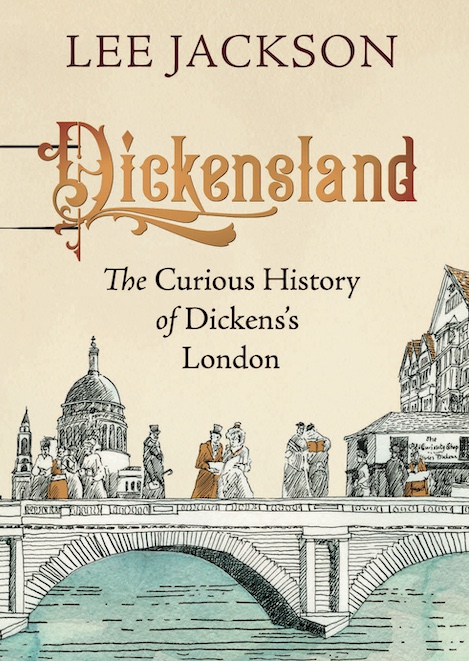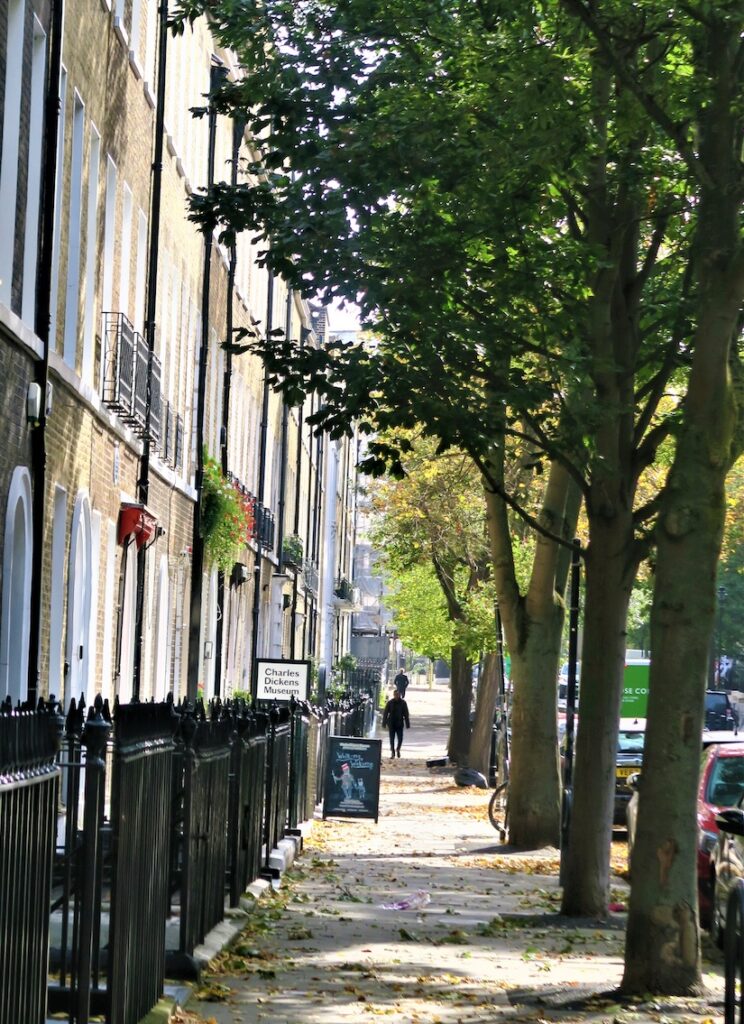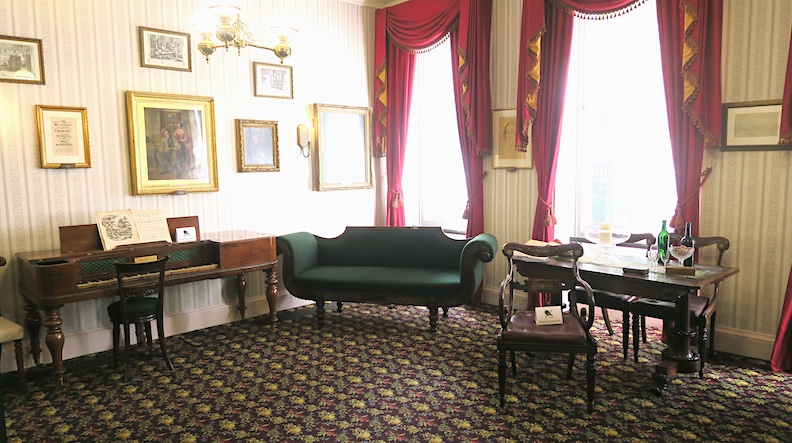
Dickensland: The Curious History of Dickens’s London
Reviewed by Nancy Wigston
Before Charles Dickens’s bones were laid to rest after his death from a stroke in 1870 literary tourists already were arriving in London, eager to experience for themselves the world that the 58-year-old writer brought so vividly to life in fifteen novels and countless short stories and essays.
Variously described as a literary superstar, the world’s first celebrity and, not incidentally, a social reformer, Charles Dickens created characters and places that continue to resonate in the popular imagination. Most recently, Barbara Kingsolver’s 2022 novel Demon Copperhead, co-winner of the 2023 Pulitzer Prize and winner of the Women’s Prize for Fiction, cleverly echoes the characters met and dilemmas faced by an orphaned American boy in Appalachia very much like Dickens’s David Copperfield who was very much like Dickens himself.
Lee Jackson’s work includes several portraits of Victorian England. He also has authored his own walking guide to Dickens’s London, therefore making him an ideal companion to “Dickensland,” the geographical locations—inns, graveyards, villages, country houses, and most all, the gritty streets of London—that appear in Dickens’s fiction. Yet these places often prove difficult to find. Either they never existed in the first place, or their real-life inspirations had been disappearing even as Dickens was describing them. For instance, the coaching inns and the travelers they welcomed, like the merry characters in The Pickwick Papers (1836-37), were fast being replaced by railway stations and train passengers by the time Dickens’s novel was published. Described and illustrated in loving detail in the book, these inns were rare on the ground by the time literary tourists started arriving to visit them.
Despite many locations being decrepit or gone, ingenious innkeepers with even a scrap of a link to the writer managed to prosper from growing literary tourism. A whole cottage industry sprung from Dickens’s wildly popular novels, with actors playing (often multiple) familiar characters from the novels in music halls and stage plays–tragic Lady Dedlock’s role was performed on stage even before the final chapter of Bleak House was published. Londoners proved more than capable of satisfying the appetites of fans hungry for “great, rambling, queer old places” that Dickens too loved, like the inns in Southwark’s Borough High Street described in Dicken’s first bestselling novel.
Perhaps no one showed more entrepreneurial zeal for literary tourism than the proprietor of The King’s Head in Chigwell, a village a short train ride from London, on the edge of Epping Forest. Considered the model for the Maypole Inn in Barnaby Rudge, The Kings Head not only retained its charms but was also located in the same countryside as Dickens’s novel, which, ironically, dealt with the perils of living in the past. No matter. Dickens fans wanted the past, and Jackson explores the growing tensions between those favoring what we’d call urban renewal (slum clearance) and the champions of the Old England portrayed in the novels.
King’s Head landlord Walter Lewis encouraged literary associations by naming rooms after Barnaby Rudge characters. Also on hand was music hall star Bransby Williams, a “Dickensian quick-change artist”—photos show him posed as characters from many of the famous novels. Williams “roped in his music hall friends” for King’s Head charity performances. Similarly, in London, actress Jennie Lee built a career playing the crossing sweeper “Little Jo” from Bleak House in a play at The Globe, called simply “Jo.” It ran for twenty years.
Many of these theatrical efforts, says Jackson, traded on the Victorian idea that “the more one is presented with the reality of a real-world place, the better one can imagine it,” thus taking the “topsy-turvy logic of literary tourism to its natural conclusion.” The Kings Head still exists, but its Dickensian associations have waned over time, and the building is now occupied by a barbecue/kebab restaurant with extravagant selfie-worthy décor (enormous stuffed animals, cars, colossal chandeliers). Dickens “is reduced to a footnote on the company’s website.”
Meanwhile, back in Southwark, The George, a 17th-century pub well predating Dickens (and mentioned just once, in Little Dorrit) has grown in historical stature under the aegis of Britain’s National Trust. Of all the vanished coaching inns on the banks of the River Thames, The George seems to best embody the “cozy, old fashioned, jovial and convivial” spirit of Old England sought by out by literary tourists. This Dickensian mood was cultivated by “manageress” Amelia Murray, succeeded by her daughter Agnes, who ran the place until 1934, surrounded by “old photographs, pictures and ornaments that exemplified the “slightly quaint, slightly backward Britain beloved of the American tourist.”
In his lifetime, Dickens achieved global fame, and nowhere was his popularity greater, perhaps, than in America, where his dramatic readings from his books filled halls–he performed A Christmas Carol at Boston’s Omni Parker House Hotel in 1862. Crowds in New York City waited on the docks for the arrival of the ship from England carrying the latest installment of The Old Curiosity Shop–frantic to learn the fate of Little Nell.
One of the liveliest passages in Jackson’s book describes Louisa May Alcott (who’d later write Little Women) enjoying the last week of her 1865-66 European tour. She’d been hired as nursemaid to an invalid, and then returned on her own—somewhat of a trailblazer–to London, to visit some of her favorite haunts from the novels she adored. (Dickens, of course, was not yet dead.) Alcott—could–and would–quote from the novels verbatim. With American academic Moses Tyler, “the professor,” as her chaperone, she searched out shabby Kingsgate Street in Holborn, home to the fictional Mrs. Gamp from Martin Chuzzlewit. The popular comic character, an incompetent, untrained, umbrella-carrying nurse given to drink, was hugely popular.
When Louisa’s guide jokingly asks after the fictional nurse, the two visitors are directed around the corner by helpful inhabitants (to be fair, a real nurse Gamp lived close by). Louisa can hardly contain herself. “Miss Alcott had to continually turn her back to hide her laughing, and finally ran away to the end of the street to let off,” Tyler wrote to his wife. Alcott later published this story and others about her day in a piece she called “A Dickens Day.”
Kingsgate Street fell to slum clearance as the drive to modernize London’s Victorian grottiness gained traction with residents, if not with tourists. Headlines mourning the “Disappearance of Dickens’s London” became more frequent as streets like Kingsgate vanished in place of Paris-like boulevards. Still, there were places left in London that resembled those in his novels: the Inns of Court, and the fetid graveyard (eventually cleared away) visited by Lady Dedlock and Little Jo in Bleak House. Yet the fact is, Dickens rarely used tangible locations in his fiction—or not enough to satisfy his questing readership. The most egregious example of Dickensian fakery was The Old Curiosity Shop, on Portsmouth St., which certainly looked old, and where curios and souvenirs were sold. A sign above the door boldly proclaimed the name of the shop where Little Nell had passed her days before being evicted. The owners kept this fantasy alive for decades, noting that when one American fellow asked to see Nell’s bedroom, he came away dejected by its lack of authenticity. He’d been hoping to find a Dickens manuscript or two, a few relics of Nell’s, perhaps. “But there wasn’t so much as a hairpin.”

The Charles Dickens Museum is on a tree-lined street in London’s residential neighborhood of Bloomsbury. Photo by Nancy Wigston
Dickens understood the refusal to let go of the past, though he sometimes viewed it as unhealthy—think of Miss Havisham and her crumbling wedding feast–especially if it meant ignoring social and political issues. Moreover, he was not above exploring his own invented literary landscape with friends, to the extent of playfully pretending, relates Jackson, that he “saw” his characters in the street. ‘“Mr. Micawber is coming; let us turn down this alley to get out of his way.’” And he was a notable performer, enjoying his remunerative stage readings–472 in all. On stage, he brought to life the jumble of the London he knew with its endless cast of quirky characters. During a visit to Philadelphia, he longed, he said, to find at least one “crooked street.”
Jackson’s account of the films of Dickens’s work—the first full-length feature appeared in 1913—is both knowledgeable and lengthy. Before that there were recreations of “Dickens’s London” at various exhibits and world fairs, and later a Dickens theme park in Chatham that proved too far from London to be a long-term success, though the “Great Expectations” boat ride sounds like it might have been fun. While pondering the ethical/moral questions surrounding literary tourism, Jackson mentions an early essay by Virginia Woolf (she’s against it) and offers Dickens’s own pretentiously silly Mrs. Wititterly, in Nicholas Nickleby, a portrait that carries “a strong hint that literary tourism is foolish, chasing ghosts in an empty house.”
And yet, Dickens himself was just such a tourist, visiting Shakespeare’s house in Stratford, “signing the guestbook, and sitting in Shakespeare’s chair.” In Italy, he visited sites in Verona associated with Romeo and Juliet. In London, he took his American publisher to “Dr. Johnson’s house in Bolt Court and to his own old chambers in Furnival’s Court.”
Today’s visitors to London can be reassured by at least one authentic site: the home where Dickens and his young family lived, at 48 Doughty St in Bloomsbury. Charles Dickens, twenty-four years old, in 1837 purchased this elegant terrace house that since 1925 has served as The Charles Dickens Museum.

Charles Dickens’s drawing room at 48 Doughty Street in London. Photo by Nancy Wigston
Described by the writer as a “frightfully first-class Family Mansion, involving awful responsibilities,” the museum, according to its brochure, is “presented as an early Victorian family home, arranged over five floors reflecting the domestic layout Dickens would have known.” It showcases 100,000 objects, including personal possessions like Catherine Dickens’s engagement ring, Dickens’s handwritten novel drafts and his writing desk. The living room evokes the warm family atmosphere in the home where the reformed Scrooge visits his young relatives in A Christmas Carol. A small shop sells tea and cakes which visitors can enjoy in the welcoming rear garden.
Changing themes reflect the seasons—one recent October, there were haunting depictions of Marley’s ghost on the walls and the writer’s ghostly tales were featured in the museum’s Old Curiosity Gift Shop. Last November, visitors were invited to follow a Family Trail through the house focusing on “Dickens and the London Fog” (caused by burning coal), where kids could investigate various noxious odors. “Victorian London was a filthy place,” introduced this jolly theme. Dickens no doubt would agree.
That a boy like Charles, sent by his bankrupt father to work in a boot blacking factory at age twelve, could, as a result of his writing, move into a house like this at age 24 speaks volumes about this writer’s popularity with what Jackson calls “a particularly obsessive fanbase” and later, of the films and TV series they inspired. Worth a visit, as they say.![]()
Dickensland: The Curious History of Dickens’s London
By Lee Jackson, Yale University Press
New Haven and London, 272 pp, $28.95
ISBN 978-0-300-26620
Among Nancy Wigston’s recent articles for the East-West News Service is an account of a river trip through the Aquitaine region of France and a memoir of four seasons of shopping in pursuit of the perfect memory.

